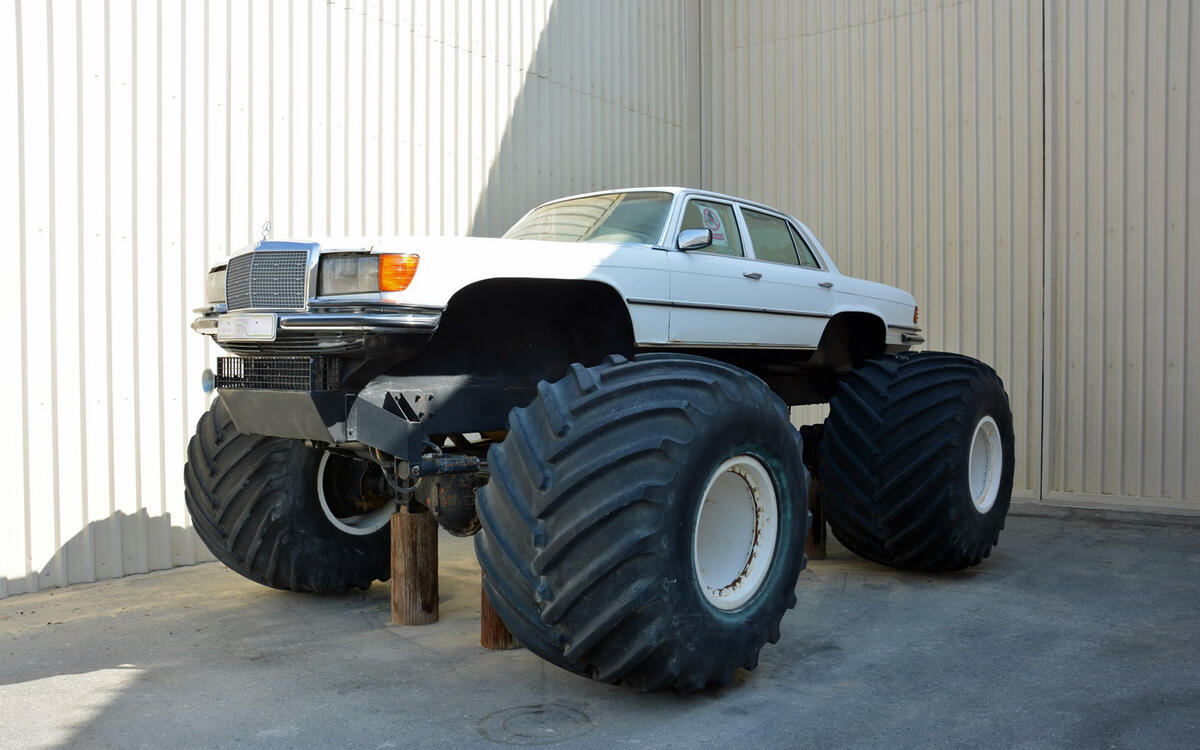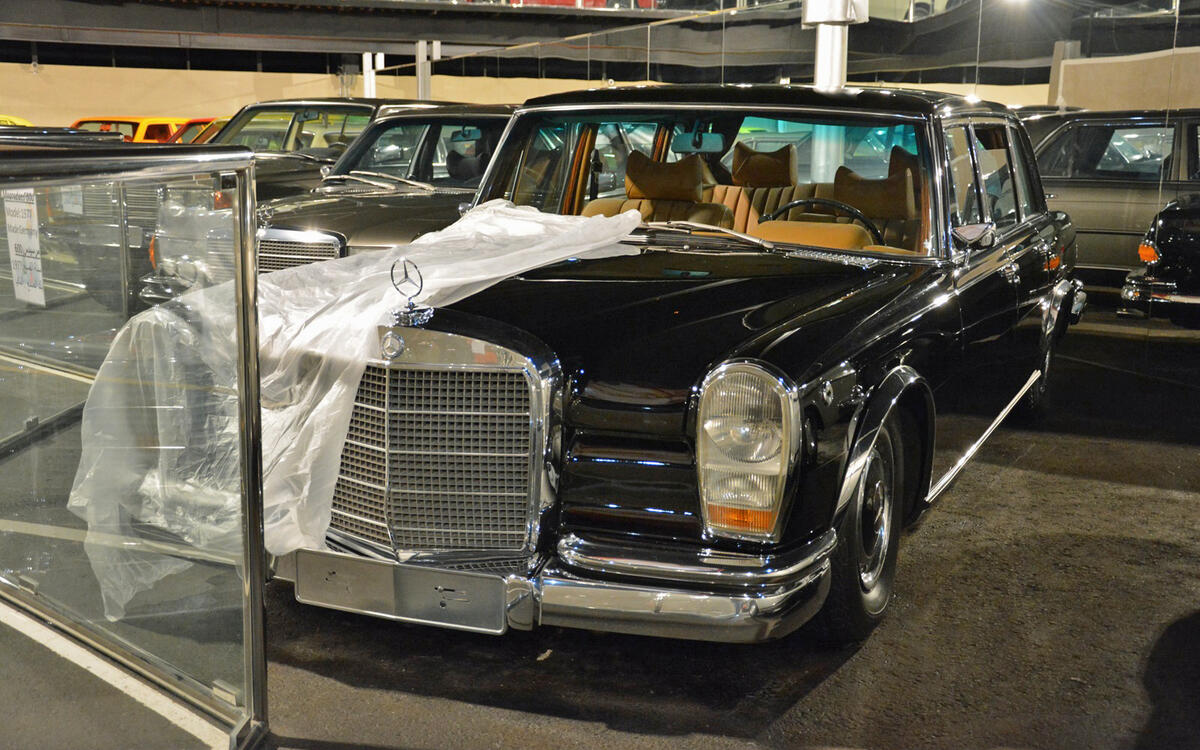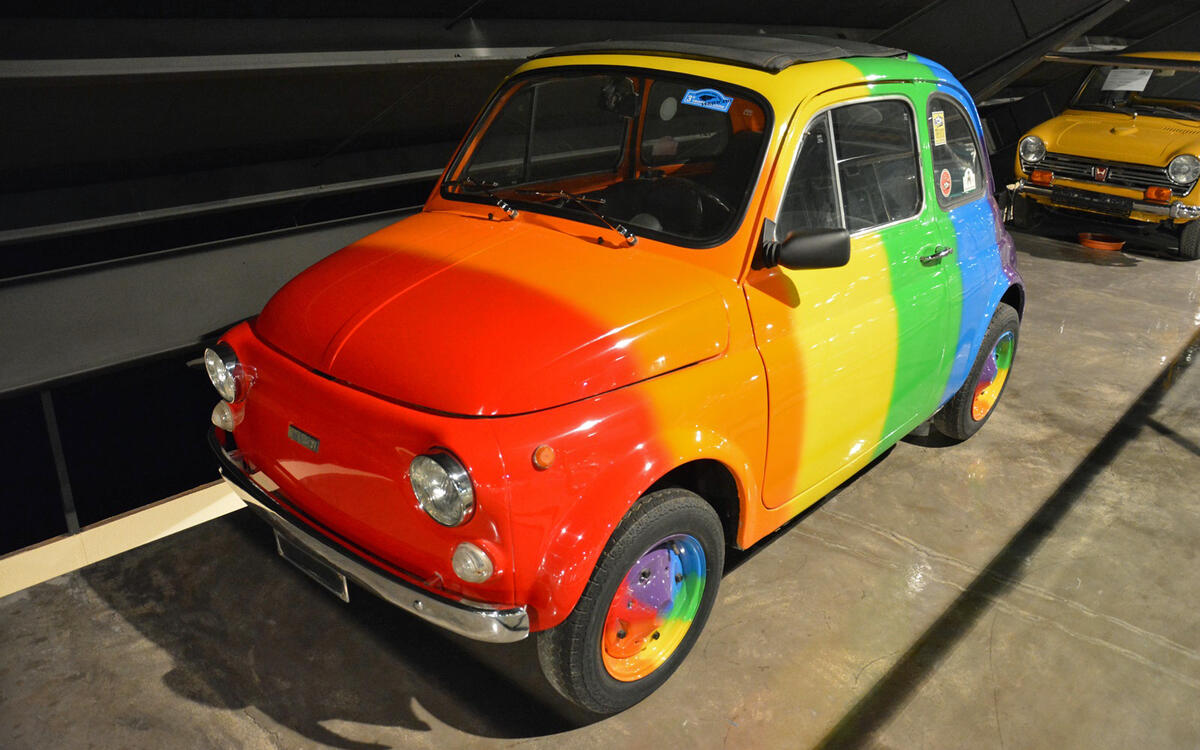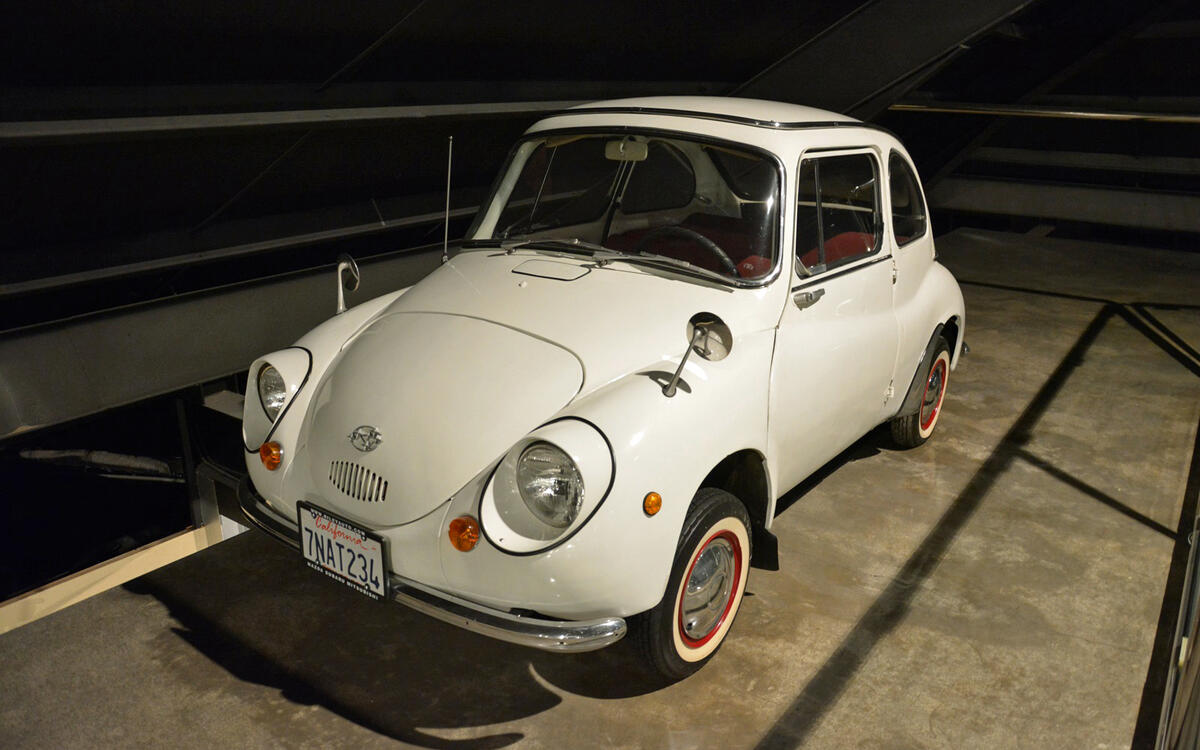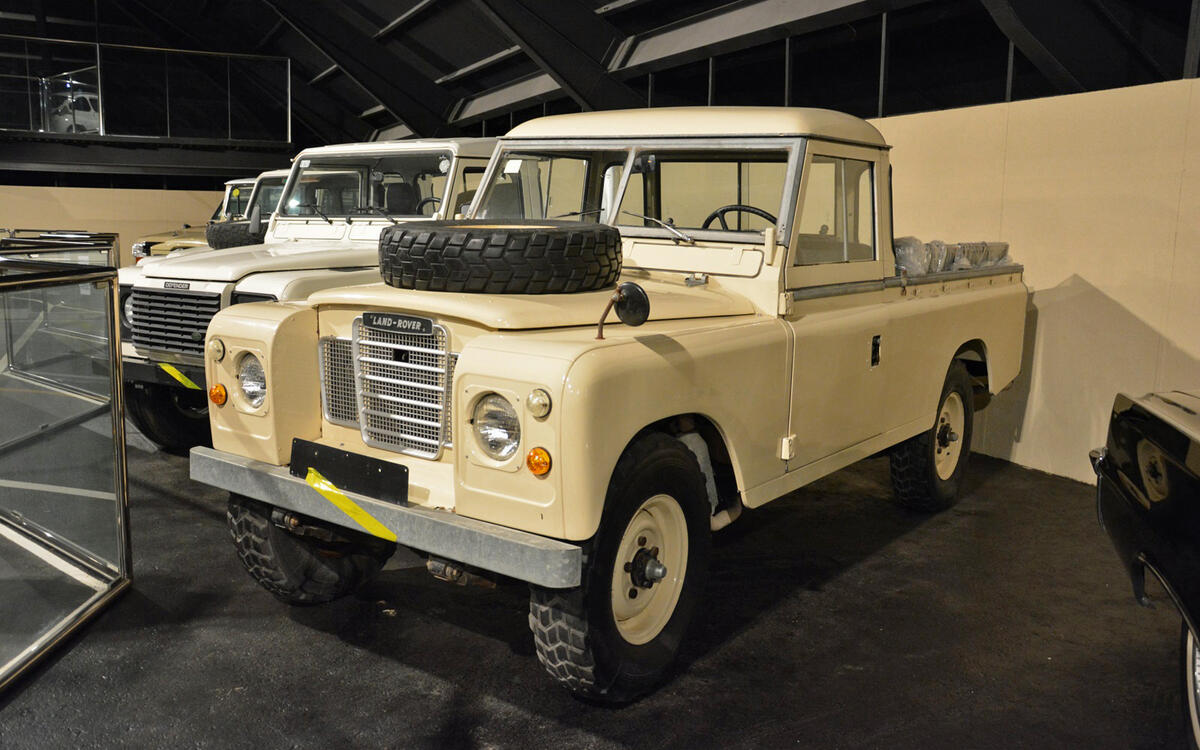 Slide of
Slide of
Unveiled to the world in early 2019, you're looking at the world's largest SUV.
In the lower half it's an Oshkosh M1075, an all-terrain 10-wheeler truck more usually deployed by the US Army. On top however it's a Jeep Wrangler, while overall power comes from a 15.2-litre Caterpillar diesel, good for 600 hp. It's a cool 10.8 metres long (35 feet) and 3.2 metres (10 feet) high. Oh, and it has headlights from a Ford F-Series Super Duty and rear lights from a Dodge Dart, as you do.
The owner of this intriguing confection is none other than Sheikh Hamad bin Hamdan al Nahyan - and he's no ordinary billionaire. As a high-profile member of the United Arab Emirates royal family, the man known as the Rainbow Sheikh once paid to have a series of canals that spelled out his first name carved into an island located off the Abu Dhabi coast.
But this vast SUV (called the Dhabiyan) is far from his only car. Indeed, it's just the latest in a long line of vehicles in his personal collection that also doubles as the country’s national car museum and earlier this year Autocar paid it a visit.
Considering the sheikh's net worth is in the vicinity of $20 billion (£15 billion), you might expect a building full of rare, powerful supercars. However, there are none to be found and the museum is all the more fascinating to visit because of it. It’s an eclectic collection of oddities peppered by stellar examples of 1980s tuning. Join us for a virtual tour of one of the most mystifying car collections in the world and see why we think it was one of our highlights of 2019:
 Slide of
Slide of
The giant Land Rover
The Emirates National Auto Museum is located in a pyramid-shaped building that’s about an hour away from central Abu Dhabi in the United Arab Emirates. After leaving the city, getting there is a matter of following the long, straight roads that cross the desert. You know you’ve arrived when you see a mammoth replica of a Land Rover Series 3 that effortlessly dwarfs a Nissan Patrol.
 Slide of
Slide of
The giant Jeep
The second house-sized car parked outside of the museum is a replica of a Willys Jeep complete with a shovel and an axe mounted on the driver’s side of the body. It rarely moves but it’s drivable from a seat hidden behind the grille. At 21ft tall it's four times bigger than an actual Willys and it's certified by Guinness as the largest Jeep replica in the world.
 Slide of
Slide of
Mercedes-Benz W116 monster truck
The Rainbow Sheikh has a soft spot for odd, obscure and underappreciated vehicles and he frequently makes his wildest dreams a reality. This is evident before you walk in: there is a Mercedes-Benz W116 turned into a monster truck parked in front of the museum. It was developed and built to be used but it hasn’t turned a wheel in quite some time.
 Slide of
Slide of
Mercedes-Benz R107 SL
Hamad bin Hamdan al Nahyan’s fascination with the colors of the rainbow earned him the nickname Rainbow Sheikh. Many of the cars in his collection consequently wear rainbow accents, including this R107-generation Mercedes-Benz SL. Every part that’s chromed on a standard SL has been gold-plated on this example and the flag ports indicate it was driven in parades.
 Slide of
Slide of
Mercedes-Benz 500SEC by Styling Garage
Hamburg-based tuner Styling Garage converted this 1983 Mercedes-Benz 500 SEC into a tuner’s dream come true during the 1980s. The modifications included widening the wheel arches, adding custom bumpers on both ends and installing a pair of gullwing doors.
 Slide of
Slide of
Riding with a falcon
The modifications made to the Mercedes-Benz 500 SEC by Styling Garage continue inside with an AMG steering wheel painted white, re-upholstered seats and a new-look dashboard fitted with gold accents. The finishing touch is a falcon-shaped shift lever sculpted from a solid block of wood.
 Slide of
Slide of
Mercedes-Benz 600
Mercedes-Benz designed the 600 limousine to carry the world’s wealthiest individuals so it’s no surprise to see one in the Rainbow Sheikh’s collection. The list of famous 600 owners includes David Bowie, Elvis Presley, Coco Chanel, Josip Broz Tito, Leonid Brezhnev, Mao Zedong and Saddam Hussein.
Made in 1977, this short-wheelbase example is in immaculate condition inside and out.
 Slide of
Slide of
Mercedes-Benz V123
The V123 was the factory-produced long-wheelbase version of the Mercedes-Benz W123. Some were converted into hearses and ambulances by coachbuilders like Binz while others – including the Sheikh’s – were sold to private buyers as limousines. Don’t let the SUV-like ground clearance fool you; it shouldn’t ride higher than a regular W123 but it’s propped up by sturdy pieces of wood.
 Slide of
Slide of
Mercedes-Benz 500 SEL
We told you the Sheikh likes the colors of the rainbow. Used for parades and special events, this Mercedes-Benz W126 received a multi-colored paint job in addition to a wider rear track and a pair of side exhaust pipes. Note that the interior matches the exterior; the dashboard is orange, the front seats are yellow, the rear seats are green and the parcel shelf is blue.
 Slide of
Slide of
The rainbow Mercedes-Benz 500 SELs
The Rainbow Sheikh ordered seven new Mercedes-Benz W126s for his wedding and asked that each one be painted in one of the colors of the rainbow with matching upholstery inside. Paint aside, the seven cars are identical. All of them are V8-powered 500 SEL models made in 1983 and each one gained a rifle rack in the cargo compartment.
 Slide of
Slide of
Mercedes-Benz 1001 SEL
Mercedes-Benz never made a car named 1001 SEL; tuner Gemballa did. Starting with a 500 SEL, the firm added gold trim, alloy wheels plus lavish interior appointments like wall-to-wall leather upholstery, a television and privacy curtains. Other tuners performed similar modifications and the cost of the build sometimes matched the price of the donor vehicle.
Why 1001? It’s not, as the name implies, because the car has a 10-litre engine. Most historians agree that a customer who ordered a tuned 500 SEL concluded the final product was twice as good as what he could get through Mercedes and declared it a 1000 SEL. This led to several variations of the nameplate including 5000 SEL and even 100000 SEL – complete with a matching emblem out back.
 Slide of
Slide of
Citroën DS
The Citroën DS – a staple in just about every car museum around the world – stands out as one of the few French cars in the Rainbow Sheikh’s collection. He chose a later, fuel-injected model and parked it next to a Traction Avant, its predecessor.
 Slide of
Slide of
Teilhol Tangara
Rare even in its home country of France, the Teilhol Tangara was a Citroën 2CV-based beach car designed to pick up where the Mehari left off. It was introduced in 1987, the same year Mehari production ended, and it came with a 2CV-sourced 602cc flat-twin engine. The example in the Sheikh’s collection is one of the very few fitted with four-wheel drive.
Teilhol equipped later examples of the Tangara with a four-cylinder engine borrowed from the AX. Production ended when the firm filed for bankruptcy in early 1990.
 Slide of
Slide of
Fiat 500
The stickers on this Fiat 500 indicate it spent the bulk of its life in Treviso, an Italian town located a stone’s throw from Venice. Peeking inside the car reveals it was originally painted in an uncommon shade of orange. We don’t know when it joined the Sheikh’s collection but it likely received the rainbow treatment after disembarking in the United Arab Emirates.
 Slide of
Slide of
Volkswagen Beetle dune buggy
This Volkswagen Beetle was transformed into a dune buggy in the United Arab Emirates. It lost its four fenders, its running boards and its original lights during the conversion and it gained massive tyres. The end result looks markedly different than the dune buggies made in the US and in the UK.
 Slide of
Slide of
Mini Moke
The Sheikh has several variations of the Mini in his collection and none are rainbow-themed. This Moke is in near-new condition as evidenced by the plastic wrappers still on the seats. The yellow headlight bulbs suggest it was sold new on the French market. The collection also includes an Italian-built, Innocenti-badged Mini Cooper, a late-model Rover Mini Convertible and a first-generation BMW Mini.
 Slide of
Slide of
Erad Junior
French minicar manufacturer Erad released the Junior in 1988. Much smaller than a Smart ForTwo, the Junior was a voiturette that motorists could drive without a regular driver’s licence. Erad fitted it with headlights from a Peugeot 205 in order to keep costs in check yet it went through the trouble of making the windshield, the roof and the doors into a single unit that could be removed to go topless.
Erad made a handful of examples of the Junior. Very few examples remain and the Sheikh’s is likely the only one lucky enough to live in a museum.
 Slide of
Slide of
Premier Padmini
In 1954, Premier began assembling Fiat’s 1100 and Topolino models from complete knock-down (CKD) kits for the Indian market. The Topolino was ill-suited to Indian roads but the 1100 sold so well that local production of its successor, the 1100D, started in 1967. Premier acquired a license to build the 1100D and the necessary tooling from Fiat in 1973 and continued making it with only minor changes until 2000. Known as the Padmini from 1974 on, it was hugely popular among taxi drivers.
 Slide of
Slide of
Premier Padmini convertible
Doggedly determined to keep the Padmini in production for as long as possible, Premier released an updated model named S1 in 1996. It received a new-look design with an updated grille and mechanical modifications like a more powerful engine that shifted through a Nissan-sourced transmission with a floor-mounted gear selector.
This left-hand drive S1 has been alchemized into a convertible and a sticker on its back end suggests it spent time in Dubai before joining the Emirates museum.
 Slide of
Slide of
Honda N600
The N is the car that put Honda on the map. It went on sale in 1967 as the N360 with – as its name implies – a 360cc two-cylinder engine. Honda stuffed a bigger, 600cc twin behind the grille to export the model to the United States and Europe. Though small and underpowered, the N360 and the N600 paved the way for more successful models like the Civic and the Accord.
 Slide of
Slide of
Subaru 360
Every member of the Subaru line-up traces its roots back to the homely 360. Developed to comply with Japan’s kei car regulations, the 360 got its name from the 360cc, two-cylinder engine mounted behind the passenger compartment. It’s one of the models that helped put Japan on wheels.
The 360 went on sale in its home country in 1958. 10 years later, entrepreneur Malcom Bricklin founded Subaru of America to begin importing the 360 to the US. It was exempt from safety standards due to its low weight but Consumer Reports nonetheless dubbed it ‘the most unsafe car on the American market.’ It sold relatively well considering it was classified as a death trap and advertised as being cheap and ugly. The Sheikh's 360 came from California.
 Slide of
Slide of
Daihatsu Midget II
The Daihatsu Midget II is small and narrow even by Japanese standards. Introduced in 1996 to compete in the kei car segment, it offered buyers a long list of options including one- and two-seater configurations, four-wheel drive and an automatic transmission. The driver sits right over the three-cylinder engine, a packaging solution that helped Daihatsu design a pickup that fits in the back of a Ford F-150.
 Slide of
Slide of
Toyota Crown
Export documents taped to the rear window of this 1971 Toyota Crown Super Deluxe reveal it originated in Belgium. It’s peppered by small battle scars (including superficial rust in the wheel arches and a bent front bumper) which indicate it was used regularly for most of its life.
 Slide of
Slide of
Nissan Cedric
This 1999 Nissan Cedric looks like it has never been driven. When new, it appealed to buyers seeking a large, four-door model with a sizable dose of classicism. It’s a left-hand drive example so it wasn’t originally delivered in Japan but the path it followed to reach the Sheikh’s collection is an enigma.
 Slide of
Slide of
Datsun 280ZX
There are several Japanese sports cars in the museum, including this well-preserved Datsun 280ZX. The NACA duct identifies it as one of the last examples built while the leather upholstery suggests it’s a high-spec model. It was imported from the US.
 Slide of
Slide of
Endurance
This puzzling roadster is called Endurance. It’s a two-seater that was built in Japan in 1998, and it’s likely based on an existing car, but additional information about it seems completely lost to history. Providing information about the cars on display is not one of the Emirates museum’s strong points.
 Slide of
Slide of
Ford Crown Victoria
In 2019, there are probably more examples of the Ford Crown Victoria registered in the Gulf countries than in New York City. The Sheikh owns two of the nicest ones around. The first (pictured) is a taxi from the Los Angeles area; the second served as a highway patrol car.
 Slide of
Slide of
Pontiac Firebird Trans Am
This third-generation Pontiac Firebird Trans Am is one of several American muscle cars in the museum. Equipped with T-tops, it’s original and in like-new condition; odds are it was shipped from the US. The Chevrolet Nova behind it was modified into a drag racer, showing another facet of muscle car culture.
 Slide of
Slide of
Scaled-up Dodge Power Wagon
Trucks and SUVs are well represented in the Sheikh’s museum. The most impressive one is undoubtedly this gigantic replica of a Dodge Power Wagon, a model commonly seen in the United Arab Emirates desert during the 1950s. It’s big enough to park a full-size, 1980s Chevrolet pickup under yet it runs and drives.
 Slide of
Slide of
Willys Jeep
The dust on this Willys Jeep reveals it hasn’t moved for a while. It’s parked along with other American cars (including an AMC Pacer and a Checker Marathon) on a row of the museum that’s mostly empty. The Sheikh still has space to expand his collection.
 Slide of
Slide of
Willys-Overland Jeepster
The Jeepster is the black sheep of the Jeep family. It was released by Willys-Overland in 1948 as a more road-focused alternative to the CJ-2. It took the form of a convertible available exclusively with rear-wheel drive. It never caught on and production ended in 1950. The example in the Sheikh’s museum still wears historical vehicle plates issued in California. The Jeep Station Wagon parked next to it came from the Golden State, too.
 Slide of
Slide of
Jeep Grand Wagoneer
This late-model Jeep Grand Wagoneer is parked next to its successor, the first-generation Grand Cherokee. It’s the ultimate evolution of the model that many historians call the first luxury SUV. The Grand Wagoneer rusted well and clean ones like the Sheikh’s sky-rocketed in value during the 2010s.
 Slide of
Slide of
The Dodge Ram Suburban that never was
This 1995 Ram 2500 pickup was converted into the Chevrolet Suburban-fighting SUV Dodge refused to build during the 1990s. This transformation was rare but not unheard of in America during the 1990s. The museum didn’t provide information about who performed the conversion and when.
 Slide of
Slide of
Retro-styled Ford F-250
Another enigmatic conversion in the Sheikh’s museum is this 2010 Ford F-250. It was modified to look like a 1966 F-Series by a private company in the United Arab Emirates. The grille and the headlights are from the 1960s but they’re mounted on custom-made sheet metal. The step-side cargo box looks custom-made, too.
 Slide of
Slide of
Land Rover Series III
Toyota is the preferred off-roader brand in the Gulf countries, not Land Rover, but the Sheikh doesn’t discriminate when it comes to 4x4s. His collection includes several Land Rovers including a V8-powered 110 and a 1972 Series III pickup (pictured).
 Slide of
Slide of
Toyota Land Cruiser
Referred to in the museum as a Toyota Jeep, this short-wheelbase Land Cruiser is ready to tackle the desert. It’s equipped to receive a soft top and its windshield folds down to provide the full open-air motoring experience. The basic design dates to 1984 but this example was made in 1999.
 Slide of
Slide of
Nissan Patrol
Nissan’s Patrol stands out as one of the most popular SUVs in the United Arab Emirates. This is a long-wheelbase, fourth-generation model surrounded by the Sheikh’s beloved rainbow stripe. It’s shiny and dent-free so it was likely used for parades rather than for desert exploration.
 Slide of
Slide of
Suzuki Jimny
Many motorists in the Gulf countries prefer to drive big, powerful SUVs like the Nissan Patrol, the Toyota Land Cruiser and the Chevrolet Suburban. The Suzuki Jimny isn’t one but its off-road prowess is difficult to argue against. Every generation of the tiny SUV is represented in the museum, including the first-generation example pictured here, but the Sheikh hasn’t gotten his hands on the newest model – yet.
 Slide of
Slide of
Suzuki Jimny
Suzuki never offered the third-generation Jimny with a fold-down windscreen. The modification was done by a private company in the United Arab Emirates. The Jimny also lost its top and its doors while gaining a tow bar attached to the front end.
 Slide of
Slide of
Zamyad Z24
The Zamyad Z24 is a Nissan Junior pickup manufactured under license in Tehran, Iran. Nissan released the third-generation Junior in 1970 and it stopped building the model in 1982 but Zamyad still manufactures it in 2019. The Sheikh’s is a late-model example fitted with fuel injection.
 Slide of
Slide of
Mercedes-Benz G-Class
The highly-detailed custom paint job worn by this Mercedes-Benz G-Class is just the tip of the iceberg. It’s also equipped with a central tire inflation system, dual air horns, a fold-down bull bar and a rack for fuel cans out back. Unlike many cars in the Sheikh’s collection, this one looks like it has spent a considerable amount of time off the beaten track.
It may belong to an oil sheikh, but there's no room for supercars in this particular collection. We pay it a visit
Advertisement





